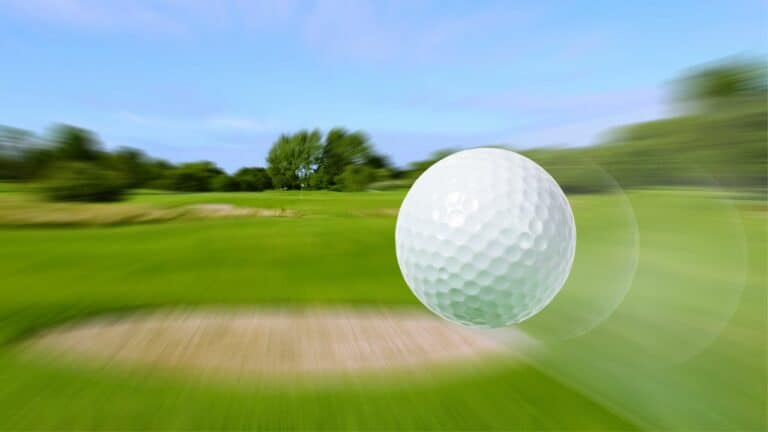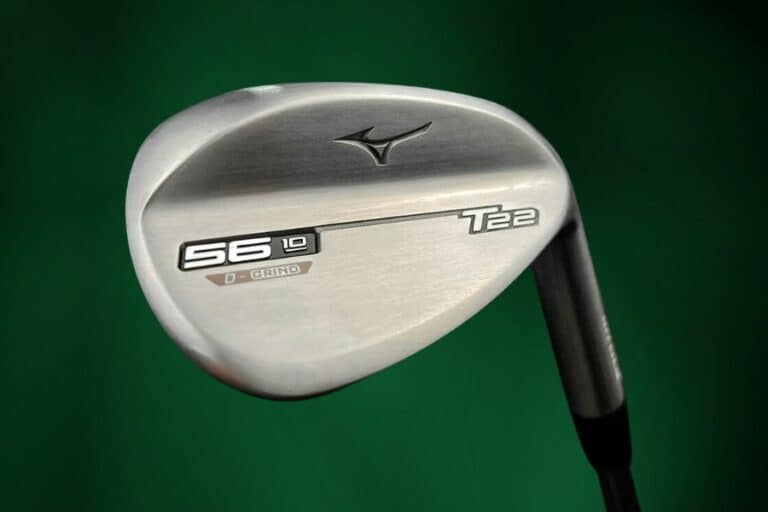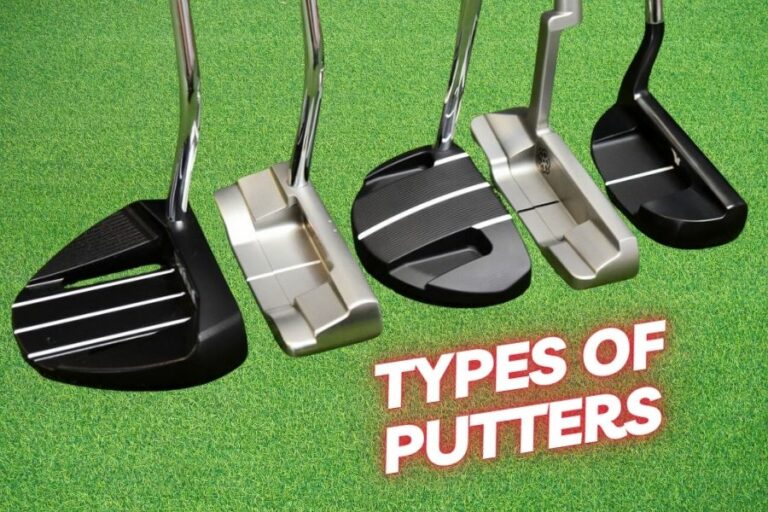Understanding Different Types of Golf Wedges: Buyer’s Guide

Want to stand out on the course with golf wedges? Here you have a complete guide for understanding different types of wedges and what factors to consider.
There are 14 types of golf clubs and golf wedges are one of them. These are specialized golf clubs that are designed to help golfers to hit the golf ball with more control and accuracy around the greens. But not all wedges are created equal.
In this article, we’ll break down the four different types of golf wedges and what factors are considered to mark the difference between them.
I. Types of golf wedges: Pitching, Sand, Lob, And Gap/Approach
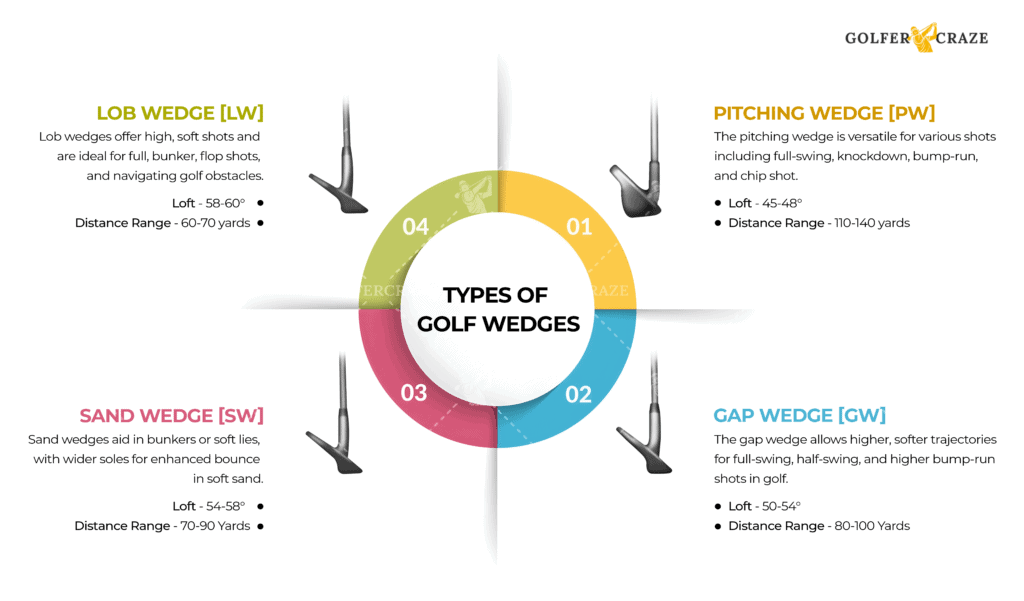
Golf wedges are an essential part of any golfer’s toolkit. They can be used when you need to hit the ball over water hazards, bunkers, or other obstacles. The four types of wedges are –
- Pitching Wedge
- Gap Wedge
- Sand Wedge
- Lob Wedge
Let’s understand each wedge in detail and find out for which shot golfers can use them and why?
1. Pitching Wedge (PW)
The pitching wedge is used to hit full-swing, knockdown, and bump-run shots. These are ideal for approach shots between 110 yards and 140 yards from the hole.
The pitching wedge loft angle is between 45 and 48 degrees. Compared to other wedges, the decreased loft angle (least loft) of the pitching wedge makes it easier to hit the ball higher, which can also be helpful when you’re trying to land the ball on a small green or avoid hazards.
A pitching wedge is even used for chip shots that need to keep on the lower trajectory.
Tip: The pitching wedge is the most common type and a great club choice as it provides increased distance approach shots. Therefore, most golfers recommend it as the must-have wedge that needs to be included in the golf bag.
2. Gap Wedge (GW)
The gap wedges are used to fill the gap between the pitching and sand wedge. They are also known as the approach wedge and are usually stamped with an ‘A’ or ‘G’ over the iron set.
The gap wedge is commonly used for shots between 80 and 100 yards from the hole. They have a loft angle between 50 and 54 degrees. It has a slightly higher loft angle on a gap wedge compared to a pitching wedge and lower loft angle than a sand wedge.
The gap wedge makes it easier to hit higher and softer shots. Typical gap wedge shots include full-swing, half-swing, and higher bump-run shots.
Tip: While selecting the gap wedge, consider the loft of the pitching wedge and sand wedge. So, the gap wedge should have a loft between the two.
3. Sand Wedge (SW)
The sand wedges are used for shots between 70 and 90 yards from the hole. These wedges have a loft angle between 54 and 58 degrees which is less than a lob wedge.
The increased loft angle on a sand wedge makes it easier to hit shots out of bunkers or soft lies. That is, it has the widest sole that enhances the bounce on the softer sand.
Sand Wedges are used to hit full-swing, half-swing, bunker shots, flop shots, and pitch and chip shots around the greens.
Tip: If you want to take advantage of the sand wedges, then you use them for hitting from a downhill lie so that it ends up in a flatter shot. Moreover, if you know how to manipulate your sand wedges’ spin, stopping power, and trajectory, then you would not have a need for a lob wedge.
4. Lob Wedge (LW)
The lob wedge is used for shots that are around 60 to 70 yards from the hole and is the highest lofted wedge. The lob wedges have a loft angle between 58 and 60 degrees and more than a sand wedge. The increased loft angle on a lob wedge makes it easier to hit high-arching, soft shots. The most common shots that are hit using the lob wedges are full shots, bunker shots, flop shots, and the best for getting over obstacles.
Tip: Depending on the swing velocity, you can use it to hit for the above-mentioned yards, but they are the best type of lob wedges when you want to hit shots inside 30 yards.
II. Major aspects to consider for wedges
Now that you know what different types of different types of wedges are, you also need to know the different aspects or factors that make them stand out. These factors need to be considered while you are purchasing, and also to find the difference between wedges shafts.
1. Loft
The loft of a golf club is the angle between the clubface and the vertical face of the club shaft. The loft angles are one of the most important factors to consider when buying a golf wedge. It determines how high and how far the ball will travel.

The higher the loft, the more vertical the clubface will be when you swing. Higher-lofted clubs are typically more difficult to hit with but can be helpful if you’re trying to hit over obstacles or landing on small greens.
Tip: If you’re unsure about which loft to choose, consult with a professional at your local golf shop or refer to the degrees of loft on the wedges diagram given below.
2. Bounce
The wedge bounce angle is the difference between the bottom of the clubface (the part that comes into contact with the ball) and where the leading edge (the part closest to you) meets the ground.
The high bounce wedges make it easier to hit out of soft lies or sand bunkers, while a lower bounce angle will help you control your shots on hardpan or tight lies.
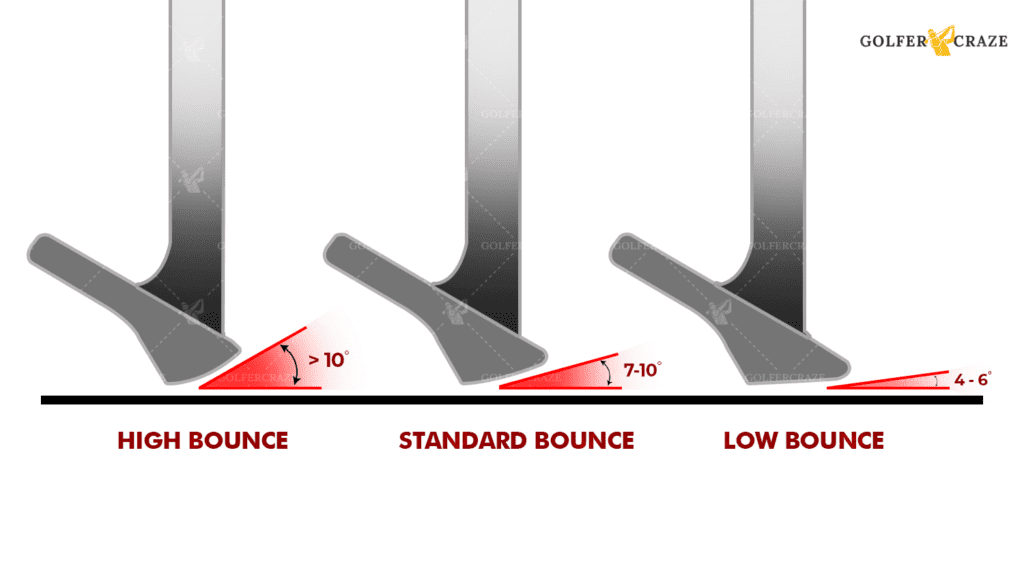
The three types of bounce angle in wedges are:
- Low-Bounce Wedges
The low-bounce wedges are ideally used to play on heavy sand traps and firm playing surfaces. The bounce angle of low-bounce wedges is between 4-6 degrees.
- Mid-Bounce / Standard Wedges
The mid-bounce wedges include the gap wedges, sand wedges, and lob wedges. The bounce angle of mid-bounce wedges is between 7-10 degrees.
- High-Bounce Wedges
The high-bounce wedges are ideally used to play on softer surfaces and for shooting out of bunkers. The bounce angle of high-bounce wedges is above 10 degrees.
3. Sole Grind
The sole grinds of a golf club refer to how much material has been removed from the sole of the club(the part that comes into contact with the ground).
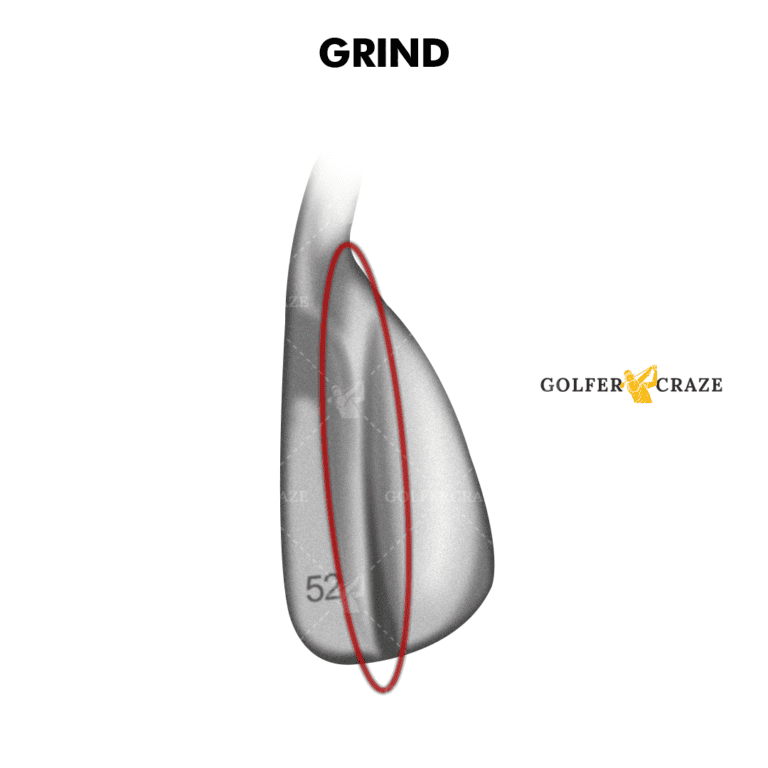
A wider sole grind will help prevent digging, while a narrower sole grind will help you control your shots around the green.
Tip: By choosing the right grind that suits the best for the turf you play (hard or soft) and your swing type (shallow or steep) can help the club perform well on difficult lies.
4. Shaft Flex
Shaft flex refers to how much bending occurs in the shaft when you swing at maximum speed. The shaft flex determines how much power you’ll be able to generate when hitting the golf ball.
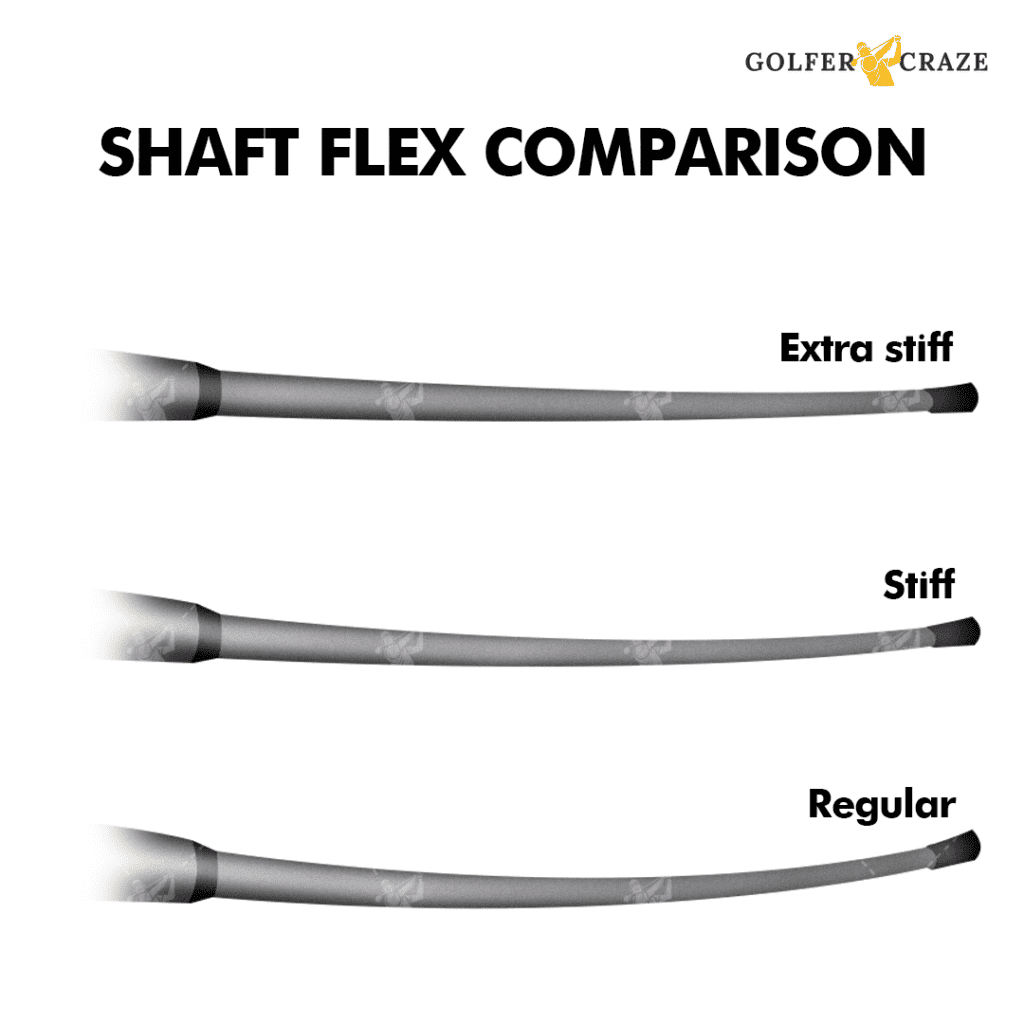
If you have a slower swing speed, you may choose a shaft with more flex so that you have more power in your shots. Meanwhile, if you have a faster swing speed, you’ll want to choose a shaft with less flex so that you can maintain control over your shots.
There are three main shaft flexes: regular (R), stiff (S), and extra-stiff flex (X).
- R-flex shafts are designed for players with slower swing speeds (under 70 mph).
- S-flex shafts are meant for players with average swing speeds (70-80 mph).
- X-flex shafts are reserved for those with above-average swing speeds (over 80 mph).
- Additional shaft flex includes shafts for ladies and seniors.
Tip: If you’re not sure what flex shaft you need, ask a professional at your local golf shop—they’ll be able to help you select the perfect one based on your individual swing characteristics.
Read More: Stiff vs. Regular Flex
5. Club Type
As we mentioned above, there are varieties of wedges available on the market. Make sure to choose the golf clubs that suit your playing style and skill level.
For instance, if you’re a beginner, you might want to start with a pitching wedge or gap wedge before moving on to more specialized clubs like sand wedges and lob wedges.
6. Grip Size
The grip size is also an important consideration when buying a golf wedge. The grip size will determine how well you’re able to control your shots.
If you have wider hands, you’ll want to choose a grip size that’s large enough so that your hands don’t feel cramped when holding the club. Similarly, if you have small hands, you’ll want to choose a grip size that’s small enough so that your hands don’t feel like they’re swinging in the grip.
7. Finish
The finish of a golf club is what protects it from rusting and wear and tear. A brushed finish will help prevent glare and increase friction with the ball, while a polished finish will help the club glide through turf and grass more easily.
III. What Wedges Do Pros Use?
What wedges you need as a pro and what configuration you may prefer to carry depends on the courses they play and their personal preferences.
Pros usually prefer the 3-wedge setup, but they may from 4-wedge setups (46-60 degrees), 3-wedge setups (46-58 degrees), or 2-wedge setups (45 degrees) to cover various distances.
The 4-wedge setup is ideal for hitting beyond 208 yards, while the 3-wedge setup offers 2-3 fairways coverage. The 2-wedge setup, also called clock face drills, helps get longer shots with either sand or pitching wedges.
The Bottom Line
Now that you know everything about golf wedges, it’s time to go out and pick up your own set!
Make sure to take into account factors for all the wedges, such as loft angle, club construction/ type, shaft flex, and grip size, before making your purchase. And if you’re still unsure about which wedge is right for you, consult with a professional at your local golf shop—they’ll be more than happy to help! We hope this guide was helpful in narrowing down your search.
FAQs
1. How Often Should I Replace My Wedges?
Wedges are designed as specialized clubs, but you cannot accurately use wedges after they have been worn. Therefore, replacing golf wedges totally depends on how often you use them and what is the durability of the equipment.
2. Which Wedge Can Be Used For Chipping?
In general, chipping with the gap or pitching wedges can help in producing more consistent shots around the green. Moreover, a gap wedge would be best for standard chips. Meanwhile, a pitching wedge could go better for balls in the rough.
3. Do Expensive Wedges Make Any Difference?
Yes, the price makes a lot of difference in the case of wedges or any other clubs. It is because the more expensive wedges are made with better material, spin control, and deliver higher shots. But, a cheap wedge will provide less when considered too costly and even start to wear and tear.




